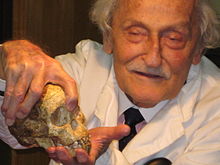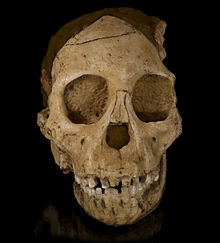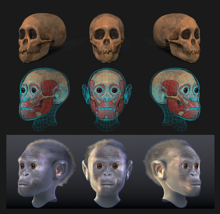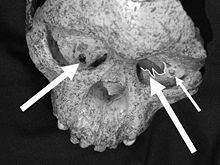Child of Taung

The child of Taung is the name given to the fossil skull of a prehistoric man who was discovered in the autumn of 1924 in Taung , which is now part of South Africa , and was dated to an age of more than two million years.
Raymond Dart , an anatomist from the University of the Witwatersrand in Johannesburg , recognized the importance of the find and published it at the beginning of 1925 in the journal Nature under the new species and genus name Australopithecus africanus . The so-called “child of Taung” was the oldest known fossil of a human ancestor and at the same time the first fossil of prehistoric humans found in Africa. It confirmed the hypothesis already put forward by Charles Darwin that humans originate from Africa, and initiated a rethink among paleoanthropologists one who, based on other fossil finds in the 1920s, were of the majority of the opinion that the Incarnation took place in Asia.
The Taung fossil is now considered “one of the three most significant finds in the history of paleoanthropology (along with the finds from the Neanderthal and Trinile ) because it is the first recognized member of a completely new, previously unknown, significant group of fossils Hominins acted. "
The skull is kept at the University of the Witwatersrand.
Description of the fossil

Raymond Dart received the fossil skull on 28 November 1924 by a foreman of Buxton- limestone fracture ( Northern Lime Company ) named M. de Bruyn , who had sent him often finds to Johannesburg.
The "child of Taung" is still considered a special find among the pre-humans. The facial skull is almost undamaged, the lower jaw is completely intact and still has almost all teeth : some milk teeth , some permanent teeth and permanent teeth that have not yet fully erupted. The canine teeth are much smaller than those of fossil and recent monkeys, and so are human-like. The occipital opening , through which the rearmost part of the brain extends to the beginning of the spinal cord , is also located below the skull, close to the center of gravity . From this it can be concluded that Australopithecus africanus could walk upright.
What is particularly impressive for the paleoanthropologists, however, is that a natural pouring of the brain capsule - the interior of the skull - has been preserved, i.e. a fossilized copy of the externally visible shape of the brain; the convolutions of the brain in the forehead area are clearly visible even to laypeople. The brain volume of the child has been given as 405 cubic centimeters since 1970 , the brain volume for the adult individual has been estimated at 440 cubic centimeters, which is roughly the size of the modern chimpanzee . For comparison: the brain of a modern person is roughly three to four times as large. A computer-aided estimate from 2007, however, came to 382 cubic centimeters for the child and 406 cubic centimeters for the adult individual; furthermore, some features of the convolutions have been interpreted as being close to Paranthropus .
A “bone seam” (metopic suture ) between the two halves of the forehead skull can also be seen in the cranial spout, which - as is usually the case with children of Homo sapiens of the same age - was not yet ossified ; In chimpanzee boys of the age of the Taung child, however, this seam is already ossified. From this it was concluded, among other things, that even in Australopithecus africanus the postnatal increase in brain volume - similar to Homo - was more pronounced than in the chimpanzees.
The age of the child at his death was initially estimated to be five to six (up to eight) years based on his teeth. Today, most researchers assume that the australopithecins grew up faster than today's humans, that is, had a much shorter childhood. The age is therefore estimated to be around three to four years. His height is estimated to be about one meter, his body weight about 35 kilograms. The period in which the "child of Taung" lived could only be estimated, namely on the basis of other fossils found in the same layer, the accompanying fauna, because the immediate vicinity of the site was destroyed by the mining of limestone ( dolomite ). before accurate analysis was possible. In the specialist literature, an age of two to three million years is therefore often mentioned; From the animal fossils found at the same time, it was concluded that it was around 2.4 million years old, but some publications also mention 2.8 million years.
Thanks to his medical, neuroanatomical training, Raymond Dart immediately recognized that although the fossil had an ape-like face, its brain and teeth were human-like. Therefore Dart argued in its written in December 1924, in already on February 7, 1925 Nature published first description offensive that important features of small skull are more human-like than ape-like, "The cheekbones , the zygomatic arches , maxillary tender leave and lower jaw, human-like characteristics (“The malars, zygomatic arches, maxillae, and mandible all betray a delicate humanoid character.”) The same applies to the brain, which also has more human-like than ape-like features: the “child of Taung” should therefore be classified as a mosaic shape , that is, as a member of “an extinct race of apes intermediate between living anthropoids and man.” ).
However, this interpretation was brusquely rejected by his British research colleagues and former academic sponsors: to them, the fossil brain appeared to be much too small and monkey-like for them to want to place the skull close to humans.
Research dispute about the position of the find in the human family tree
The editor of the journal Nature received Dart's manuscript on "Child of Taung" on January 30, 1925 and just four days later passed it on to four anthropologists, including Dart's academic supporters Grafton Elliot Smith and Arthur Keith . The editor knew that Dart's manuscript was going to spark a heated debate, and so he intended to start that debate in his journal with the four peer-to-peer opinions requested.
The publication of the darts manuscript on February 7, 1925 was immediately celebrated by the daily newspapers as a report on a newly discovered missing link . In the next issue of Nature, however, three of the four reviewers emphatically rejected Dart's interpretation of the fossil. Keith suggested categorizing the fossil as related to gorillas and chimpanzees, and Elliot Smith dismissed Dart's analysis as rash. The leading British paleontologist Arthur Smith Woodward - who in 1912 had attested the Piltdown man to be a link between ape and man, and was later ennobled like the other two - rejected the interpretation of darts, which would have suggested that development into humans had took place in Africa: “It is premature to judge whether the direct ancestors of man are to be found in Asia or in Africa. The new fossil from Africa certainly has little influence on the clarification of this question. ” Only the fourth reviewer, the anthropologist Wynfrid Lawrence Henry Duckworth from the University of Cambridge , expressed himself more cautiously, but also did not agree with Dart's conclusions.
In the following months, the rejection of the darts publication intensified to the point of open hostility. In June 1925, Elliot Smith reproached his former assistant for having no knowledge of the anatomy of young chimpanzees and gorillas and therefore failing to recognize that the allegedly human-like features of the Taung skull were essentially identical to those of young great apes. Keith published a second statement in Nature on June 22, 1925 , in which he - without having seen the skull up close - predicted that an assessment of the find by real experts would lead to Dart's interpretations as "ridiculous" ( preposterous ). Even after Elliot Smith and some of his contemporaries examined casts of the fossil under glass at the British Empire Exhibition , they stuck to their belief that it was undoubtedly a monkey. Even the naming was tried to make ridiculous: In Nature of March 28, 1925, the Greek-Latin word creation Australopithecus was ironically referred to by an anonymous author as a "disgusting hybrid" ( unpleasing hybrid ).
Nothing changed about the rejection of the first Australopithecus find by the British anthropologist establishment when Dart visited his colleagues in London in 1930 with the original of his find. Dart returned to Johannesburg disappointed, left the search for fossils to his colleague Robert Broom and concentrated on building an anatomical collection at his university. The existence of the genus Australopithecus was not included in important anthropology textbooks until the end of the 1930s, nor did it play a role in anthropology lectures at universities. It was not until February 15, 1947, that Dart's first description of the "Child of Taung" was fully rehabilitated. Again in Nature , Wilfrid Le Gros Clark was quoted, a highly respected English anatomist who later exposed the Piltdown man as a fake. After carefully examining the fossils discovered up to that point, Le Gros Clark frankly referred to the genus Australopithecus as hominid (the current name would be hominin ) and, by virtue of his authority, placed it among the pre-humans. In the same issue of Nature , the now very old Sir Arthur Keith frankly admitted in a brief statement that his earlier classification of the “child of Taung” as the ancestor of the African great apes was a mistake: “I am now convinced ... that Professor Dart was right and I'm wrong. "
Contemporary history background
Charles Darwin had already pointed out in 1871 in his work The Descent of Man and Sexual Selection ("The Descent of Man, and Selection in Relation to Sex") that due to the similarity of man to chimpanzees and gorillas, human incarnation is very likely in Africa took place. However, even after the turn of the century, Darwin's doctrine had by no means established itself as a reliable doctrine, and his well-considered references to human tribal history had not been taken up by anthropologists. On the contrary, in the 1920s they were flatly rejected due to several fossil discoveries. Instead, Asia was considered the most likely place for the Incarnation. This misjudgment can be attributed u. a. on discoveries made by the French anatomist Eugène Dubois in Java in 1891, who discovered the so-called Java man - a Homo erectus - there. The findings of another Homo erectus , the Peking man , of whom a tooth was discovered southwest of Beijing in the early 1920s and a complete skull in 1929 , finally fit into the wrong picture .
The then leading American paleontologist Henry Fairfield Osborn (an offensive proponent of eugenics and a critic of Darwin's ideas about human ancestry) had also popularized the theoretical concept of the so-called Dawn-Man ( early man or man of the dawn ), which - without fossil evidence - u. a. claimed the modern human brain was so complex that two or three million years could not have been enough to produce it from an ape-like brain. Almost all researchers in the 1920s agreed with this thesis and assumed a period of at least 20 to 25 million years during which modern humans and the modern great apes had developed separately - a thesis that was by no means new, as even Rudolf Based on similar considerations, Virchow had misunderstood the Neanderthals as a fossil species.
This now completely arbitrary assumption found support in the 1920s in the so-called Piltdown man , whose bones had been collected in Sussex from 1912 and who was only exposed as a fake in 1953. The head consisted of the skull of a modern human, to which the lower jaw of a monkey had been adapted. The forgery met the prevailing view of the time, according to which the ancestors of man had had a particularly large brain for a long time, and thus blocked the then leading British and American paleontologists from seeing the actual facts.
The turning point in favor of recognizing the Australopithecins as pre-humans only occurred when the informative value of other fossils was reassessed. More and more Neanderthals had been discovered whose physique was uniform and thus made the thesis that the first specimen found was a deformed, modern human being untenable. Since the 1940s, as a result of the growing number of finds, the skull of Piltdown had also increasingly been perceived as a curiosity that resisted a clear classification in the human family tree. The evolutionary biologist Sherwood Washburn reported, for example, that he had deliberately not mentioned the Piltdown man in a publication in 1944, "because it simply made no sense".
From 1936 onwards, further Australopithecus fossils had been discovered in Africa, which a new generation of researchers no longer primarily interpreted against the background of older doctrines on the duration of the evolution of the brain. For example, the American vertebrate paleontologist William King Gregory assigned the dentition of the Australopithecus fossils to the ancestral line of humans in a specialist article as early as 1939 . The anatomist Wilfrid Le Gros Clark, however, was still extremely skeptical about the classification of the Australopithecines as early pre-humans when he set out on a research trip to South Africa at the end of 1946. After two weeks of careful study of the bones, however, his skepticism was gone. As early as January 1947, he naturally classified the Australopithecines as hominids during the First Pan-African Congress on Prehistory organized by Louis Leakey in Nairobi .
Traces of a bird of prey
The fact that in the area of Taung, despite an intensive search, only this single finding of an Australopithecus fossil had been caused for a long time. As early as 1995, the South African paleoanthropologists Lee Berger and Ron Clarke had suggested that the animal fossils discovered in the vicinity of the site could have been carried there by a large bird of prey . They pointed out at the time that fossils of monkeys show traces that indicate the attack of a large bird of prey, and that this was also possible for the "child of Taung". However, their opinion had not prevailed in the professional world because it was believed that the child was too heavy even for a very large bird of prey.
A study published in 2006 by a British-American research group headed by Scott McGraw in the American Journal of Physical Anthropology now seems to confirm this assumption. The research team had searched the nests of 16 crowned eagles for remains of prey and a. 669 monkey bones found. These monkeys - living mostly at the bottom mangabey - had been hard to lifetime up to eleven kilogram in the Ivory Coast has previously been captured briefly by the crown eagles. Damage to many bones could be seen, which had occurred either when the prey was transported to the nest - by the claws of the bird of prey - or when it was eaten through the beak. These scratches and bite marks - including puncture holes that allowed the birds to get to the soft bone marrow and brain - were so characteristic that they prompted Lee Berger of the University of the Witwatersrand to re-examine the Taung skull. The result: the fossil skull has scratches on its upper side and puncture points in the eye sockets similar to those seen in animals captured today. In addition, it is now believed that a large bird of prey was able to capture an animal weighing 30 kilograms during the lifetime of the “child of Taung”.
Lee Berger reported that he had previously held the Taung skull hundreds of times and therefore did not expect to find any raptor tracks on it:
- “I almost fell off my stool when I looked the skull in the eye and saw the marks as described in McGraw's paper - they look like perfect examples of damage from an eagle. I could hardly believe my eyes that thousands of scientists - myself included - had overlooked the crucial damage. I immediately went to look at an original impression of the child from 1925 so that I could be sure that this damage was there from the start - and it was! I felt a bit like an idiot that I hadn't noticed these times ten years ago. "
Confirmation of the species characteristics
As a holotype of the species Australopithecus africanus, the juvenile skull is the sole measure of whether other fossils belong to this species. It was never disputed that the fossils from Sterkfontein and Makapansgat can be assigned to this species; however, even among the early hominini, the shapes of the skulls of adolescents and adults differed . However, a three-dimensional developmental computer simulation, the results of which were published in 2006, confirmed that a transformation of the juvenile skull into an adult Australopithecus - similar to the fossil Sts 71 of Australopithecus africanus - leads and not to an adult Paranthropus .
See also
literature
- Raymond A. Dart : Australopithecus africanus: The man-ape of South Africa. In: Nature . Volume 115, 1925, pp. 195–199, doi: 10.1038 / 115195a0 , ( facsimile of Dart's original publication from 1925 (PDF; 456 kB) )
- Phillip V. Tobias : Dart, Taung and the Missing Link: An Essay on the Life and Work of Emeritus Professor Raymond Dart. Witwatersrand University Press, 1984, ISBN 0-85494-801-5
- Phillip V. Tobias: Conversion in Palaeo-Anthropology: The Role of Robert Broom, Sterkfontein and other Factors in Australopithecine Acceptance. In: Phillip Tobias, Michael A. Raath, Jacopo Moggi ‐ Cecchi and Gerald A. Doyle (eds.): Humanity from African naissance to coming millennia. Firenze University Press, Florence 2001, pp. 13–31, ISBN 978-8884530035 , full text (PDF)
- Roger Lewin: Bones of Contention. Controversies in the Search for Human Origins. Touchstone 1988, ISBN 0-671-66837-4
- Dean Falk : The Fossil Chronicles: How Two Controversial Discoveries Changed Our View of Human Evolution. University of California Press, 2011 (Kindle Edition)
- Lydia Pyne: The Taung Child: The Rise of a Folk Hero. Chapter 3 in: Dies .: Seven Skeletons. The Evolution of the World's Most Famous Human Fossils. Viking, New York 2016, ISBN 978-0-525-42985-2
Individual evidence
- ^ W. Eric Meikle, Sue Taylor Parker: Naming our Ancestors. An Anthology of Hominid Taxonomy. Waveland Press, Prospect Heights (Illinois) 1994, ISBN 0-88133-799-4 , p. 52.
- ↑ Ralph L. Holloway: Australopithecine Endocast (Taung Specimen, 1924): A New Volume Determination. In: Science . Volume 168, No. 3934, 1970, pp. 966-968, doi: 10.1126 / science.168.3934.966
- ↑ Dean Falk , Ronald J. Clarke : Brief communication: New reconstruction of the Taung endocast. In: American Journal of Physical Anthropology. Volume 134, No. 4, 2007, pp. 529-534, doi: 10.1002 / ajpa.20697 . How reliable this estimate is remains to be seen, because the well-preserved skull of the adult Sts 5 (" Mrs. Ples ") is given as 485 cubic centimeters, see Glenn C. Conroy et al .: Endocranial Capacity in an Early Hominid Cranium from Sterkfontein, South Africa. In: Science. Volume 260, 1998, pp. 1730-1731; doi: 10.1126 / science.280.5370.1730
- ↑ a b Dean Falk et al .: Metopic suture of Taung (Australopithecus africanus) and its implications for hominin brain evolution. In: PNAS . Volume 109, No. 22, 2012, pp. 8467-8470, doi: 10.1073 / pnas.1119752109
- ↑ humanorigins.si.edu : dump from January 21, 2012
- ^ Raymond A. Dart : Australopithecus africanus: The man-ape of South Africa. In: Nature. Volume 115, 1925, pp. 195–199, doi: 10.1038 / 115195a0 , ( full text (PDF; 456 kB) )
- ^ R. Dart, in Nature (1925), p. 196
- ↑ R. Dart, in Nature (1925), p. 195 (original in italics)
- ^ "It is premature to express any opinion as to whether the direct ancestor of man are to be sought in Asia or in Africa. The new fossil from Africa certainly has little bearing on the question. " Quoted from R. Lewin, Bones of Contention , p. 51.
- ^ Lydia Pyne: The Taung Child: The Rise of a Folk Hero . Chapter 3 in: Dies .: Seven Skeletons. The Evolution of the World's Most Famous Human Fossils. Viking, New York 2016, p. 93, ISBN 978-0-525-42985-2 .
- ^ "I am now convinced ... that Prof. Dart was right and that I was wrong." Quoted from R. Lewin, Bones of Contention , p. 77; Lewin comments on this admission as follows: "One can hardly imagine a faster and more complete surrender."
- ^ “By this time, Piltdown just didn't make any sense.” Quoted from R. Lewin, Bones of Contention , p. 75
- ^ William King Gregory and Milo Hellman: The South African Fossil Man-Apes and the Origin of the Human Dentition. In: The Journal of the American Dental Association. Volume 26, No. 4, 1939, pp. 558-564, doi: 10.14219 / jada.archive.1939.0113
- ^ Lee Berger and Ronald J. Clarke : Eagle involvement in accumulation of the Taung child fauna. . In: Journal of Human Evolution . 29, 1995, pp. 275-299. doi : 10.1006 / jhev.1995.1060 .
- ^ W. Scott McGraw, Catherine Cooke, Susanne Shultz: Primate remains from African crowned eagle (Stephanoaetus coronatus) nests in Ivory Coast's Tai Forest: Implications for primate predation and early hominid taphonomy in South Africa. In: American Journal of Physical Anthropology. Volume 131, No. 2, 2006, pp. 151-165, doi: 10.1002 / ajpa.20420
- ↑ Lee R. Berger: Predatory bird damage to the Taung type skull of Australopithecus africanus Dart 1925. In: American Journal of Physical Anthropology. Volume 131, No. 2, 2006, pp. 166–168, doi: 10.1002 / ajpa.20415 , full text (PDF; 181 kB) ( Memento from July 15, 2011 in the Internet Archive )
- ↑ "I almost dropped down when I looked into the eyes of the skull as I saw the marks, as described in the McGraw paper - they were perfect examples of eagle damage. I couldn't believe my eyes as thousands of scientists, including myself, had overlooked this critical damage. I even went to look at an original 1925 cast of the child to make sure the damage had been there originally, and it had. I felt a little bit like an idiot for not seeing those marks 10 years ago. ”Quoted from: Lucille Davie: Who killed the Taung child? ( Memento of March 10, 2016 in the Internet Archive ) On: southafrica.info of January 13, 2006
- ^ Kieran P. McNulty et al .: Examining affinities of the Taung child by developmental simulation. In: Journal of Human Evolution. Volume 51, No. 3, 2006, pp. 274-296, doi: 10.1016 / j.jhevol.2006.04.005
Coordinates: 27 ° 30 '53.9 " S , 24 ° 50' 45.3" O


